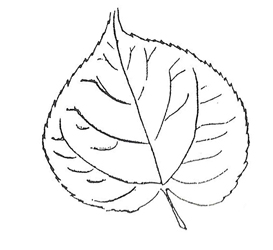American Linden: Tilia spp.
Family: Malvaceae, Mallow
Key Steps
- 1b – Alternate leaf arrangement — go to 18
- 18a – Leaf simple — go to 19
- 19b – Thornless — go to 22
- 18a – Leaf simple — go to 19
Description
 Leaf: Large (4-10 inches), heart-shaped leaf. Base is usually uneven. Tip is pointed. Three veins start at base. Auxiliary tufts of hair beneath. Coarsely toothed. May have stipules. Medium-dark green.
Leaf: Large (4-10 inches), heart-shaped leaf. Base is usually uneven. Tip is pointed. Three veins start at base. Auxiliary tufts of hair beneath. Coarsely toothed. May have stipules. Medium-dark green.
Bud: Hairless, small, pointed, shiny (2-3 visible scales, one scale is larger and bulging, giving the bud a tilted or lopsided look). Bud shaped like a teardrop. May be red, green or brown. Not stalked. Branch scar next to false terminal bud.
Leaf Scar: More than 3 bundle scars. May have stipule scars.
Stem: Newer growth: slender and green. Older growth becoming stouter, slightly zigzag, smooth.
Bark: Light brown, deeply furrowed on older trees.
Pith: Continuous, white.
Flower: Fragrant, yellow, 5-petaled, June to July. Attracts bees.
Fruit: Whitish “berry” attached by long stalk to leaf-like, light green appendage (bract), which turns tan when mature. May persist through winter.
Habit: Formal, dense, shade tree. Usually has a strong central leader. 50 feet by 40 feet.
Culture: Full sun, well-drained, moderate moisture. pH adaptable.
Littleleaf Linden (T. cordata) — Very similar, but smaller in leaf, bud and habit. 45 feet by 30 feet. Conical, dense. May sucker. ‘Greenspire’ is 45 feet by 25 feet; with glossy, dark green leaves.
Redmond Linden (T. x euchlora ‘Redmond’) — Medium to fast growth rate. Reddish bark and stems. Narrow branch unions.
Resources




